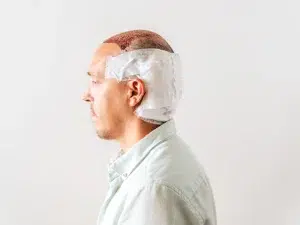Androgenic alopecia, often referred to as man-pattern baldness, is a common form of hair loss that can affect both men and women. It is characterized by the gradual thinning of hair on the scalp, leading to receding hairlines and eventual baldness.
What causes androgenic alopecia? While it is mainly a hereditary condition, several factors contribute to its development.
In this blog, we’ll explore the top 5 reasons behind this condition and discuss when it’s time to seek professional help and where.
Top factors responsible for Androgenic Alopecia

- Genetic Predisposition. The primary cause of androgenic alopecia is genetics. If you have relatives who suffer from baldness, you are more likely to develop this condition. It is inherited through a combination of genetic factors from both sides of your family.
- Hormonal Imbalance. Hormonal imbalances, specifically the increased sensitivity of hair follicles to androgens, play a crucial role in the development of androgenic alopecia. Androgens are male hormones present in both men and women and when their levels increase, it can lead to hair loss.
- Age. Androgenic alopecia typically becomes more noticeable as you age. The condition often starts in early adulthood and progresses with time. Hormonal changes that occur as you get older can exacerbate the condition.
- Poor Blood Circulation. Insufficient blood flow to the scalp can also contribute to hair loss. A lack of nourishment and oxygen to hair follicles can weaken them, making them more susceptible to hair thinning and loss.
- Lifestyle Factors. Having unhealthy habits, such as smoking, excessive alcohol consumption, and poor nutrition, can contribute to androgenic alopecia. These practices can disrupt the body’s natural balance and negatively impact hair health.
When to Seek Professional Help?
Now that you know what causes androgenic alopecia and that it is a common condition that can affect everybody, you should always consult an expert and find a professional solution to fix it whenever you experience any symptoms.
Here are some signs that it is time to look for medical care:
- Noticeable Hair Thinning. If you notice a significant and consistent thinning of your hair, it’s time to consult a professional. Early intervention can help slow down the progression of androgenic alopecia.
- Receding Hairline. A receding hairline is a common symptom of male pattern baldness. If you see your hairline moving backward, it’s a clear sign to seek expert advice.
- Family History. If you have a family history of androgenic alopecia, it’s a good idea to consult with a specialist to discuss preventative measures or treatment options.
- Changes in Hair Texture. Changes in hair texture, such as increased hair breakage or loss of hair volume, should not be ignored. These could be early signs of androgenic alopecia.
Why Capilar Hair Center?
As you see, androgenic alopecia is a complex condition with multiple contributing factors. If you suspect you may be undergoing male pattern baldness, seeking professional help is essential.
At Capilar Hair Center, a clinic focused on hair restoration in Tijuana, we offer a range of effective treatments to address androgenic alopecia, from medical therapies to surgical solutions.
For example, we are experts in Follicular Unit Extraction (FUE) and Direct Hair Implantation (DHI). These procedures are skillfully conducted by our FUE and DHI Transplant Specialist: Dr. Jorge Jimmy Cortez, an experienced specialist with a wealth of expertise in enhancing your hair’s aesthetics. Dr. Cortez is additionally recognized as a Certified Member of the International Society of Hair Restoration Surgery (ISHRS).
Don’t let hair loss affect your confidence and well-being – take the first step towards healthier, fuller hair by consulting our experts today.
Before you go, do not forget to visit our hair restoration blog section, where you’ll find the answer to your questions. Your journey to hair restoration begins with a hair transplant in Tijuana!






